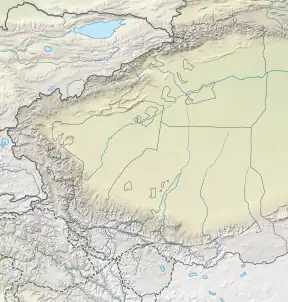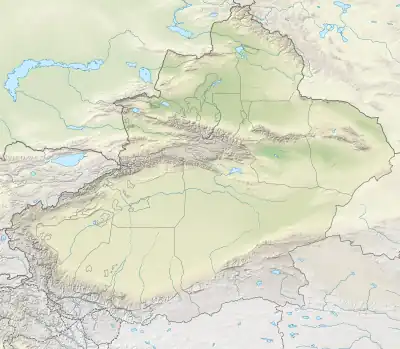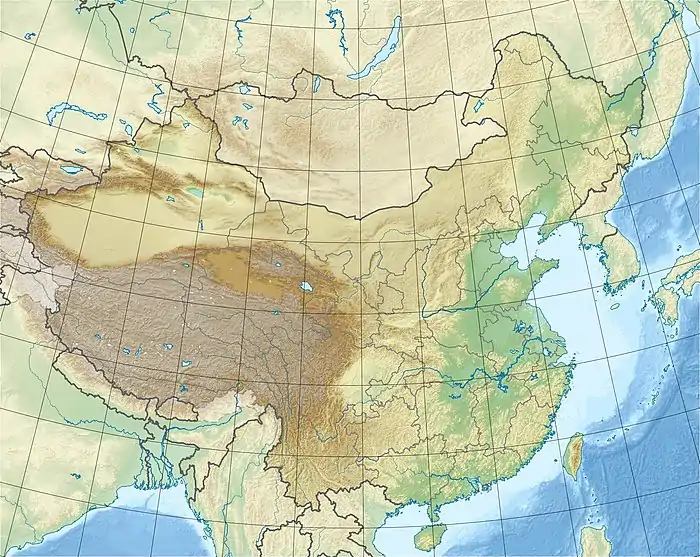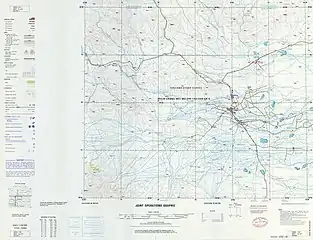Shufu County
Shufu County, also transliterated from Uyghur as Konaxahar County or Konasheher County[5]/Kona Sheher County,[6][7] is a county in Kashgar Prefecture, Xinjiang Uyghur Autonomous Region, China. It contains an area of 3,513 km2 (1,356 sq mi). According to the 2002 census, it has a population of 360,000.
Shufu County
Konaxahar, Konasheher, Kona Sheher | |
|---|---|
.jpg.webp) Aerial view | |
.png.webp) Location of Shufu County (red) within Kashgar Prefecture (yellow) and Xinjiang | |
 Shufu Location of the seat in Xinjiang  Shufu Shufu (Xinjiang)  Shufu Shufu (China) | |
| Coordinates: 39°21′00″N 75°51′03″E | |
| Country | China |
| Autonomous region | Xinjiang |
| Prefecture | Kashgar |
| County seat | Tokkuzak[1][2] |
| Township-level divisions | 4 towns; 6 townships; other areas |
| Area | |
| • Total | 2,709.47 km2 (1,046.13 sq mi) |
| Population (2020)[3] | |
| • Total | 263,014 |
| • Density | 97/km2 (250/sq mi) |
| Ethnic groups | |
| • Major ethnic groups | Uyghur[4] |
| Time zone | UTC+8 (China Standard[lower-alpha 1]) |
| Postal code | 844100 |
| Website | www |
| Shufu County | |||||||||||
|---|---|---|---|---|---|---|---|---|---|---|---|
| Uyghur name | |||||||||||
| Uyghur | قەشقەر كونا شەھەر ناھىيىسى | ||||||||||
| Literal meaning | Kashgar Old Town County | ||||||||||
| |||||||||||
| Chinese name | |||||||||||
| Simplified Chinese | 疏附县 | ||||||||||
| Traditional Chinese | 疏附縣 | ||||||||||
| |||||||||||
| Alternative Chinese name | |||||||||||
| Simplified Chinese | 阔纳协海尔县 | ||||||||||
| Traditional Chinese | 闊納協海爾縣 | ||||||||||
| |||||||||||
| Second alternative Chinese name | |||||||||||
| Simplified Chinese | 喀什噶尔阔纳协海尔县 | ||||||||||
| Traditional Chinese | 喀什噶爾闊納協海爾縣 | ||||||||||
| |||||||||||
According to a list obtained and partially verified by the Associated Press, Shufu county has the highest imprisonment rate of any location in the world.[8]
Name
The names of "Shufu County" and nearby "Shule County", transliterations of local language names from Han Dynasty corresponds to its Uyghur names, "Kona Xahar" (meaning 'old city'[1]) and "Yengi Xahar" (New City) respectively. The names for the two counties in both languages may share their origins in languages of the Saka people, residents of Kashgar area before its linguistic Turkification in as late as the 11th century.[9]
History
The county was established in 1882.[1]
In 2013, Awat Township (Awati; ئاۋات يېزىسى / 阿瓦提乡) and Yëngi'östeng Township (Yingwusitan; يېڭىئۆستەڭ يېزىسى / 英吾斯坦乡) were transferred to Kashgar city.[2]
On December 15, 2013, 16 people were killed in an attack on a police station. A group, armed with knives and bombs, attacked the police station and killed two police officers.[10] In the aftermath 14 of the 16 attackers were killed by police special units.[11]
On April 28, 2014, Chinese Communist Party General Secretary and President Xi Jinping visited Tokkuzak (Tuokezhake) during his inspection tour of Xinjiang.[12]
On October 21, 2014, Aqqash Township (Akekashi) was transferred from Konaxahar (Shufu) County to Kashgar city.[2]
In 2017, Erkin Ayup, brother of Abduweli Ayup, who had recently been promoted as head of oversight for the Organization Department of the Committee of the Chinese Communist Party in his hometown of Tokkuzak (Tuokezhake), went missing. In an interview conducted by Radio Free Asia, a staffer at his former office said he had been sent to an internment camp near Kashgar Airport.[13]
In interviews with Radio Free Asia in 2020, residents and officials of the county stated that it was no longer possible to perform traditional Uyghur nikah marriage rites in the county.[14]
Administrative divisions
Shufu County included 4 towns, 6 townships.[2][15]
| Name | Simplified Chinese | Hanyu Pinyin | Uyghur (UEY) | Uyghur Latin (ULY) | Administrative division code | |
|---|---|---|---|---|---|---|
| Towns | ||||||
| Tokkuzak Town (Tuokezhake,[16] Toqquzaq[7]) |
托克扎克镇 | Tuōkèzhākè Zhèn | توققۇزاق بازىرى | toqquzaq baziri | 653121100 | |
| Lengger Town | 兰干镇 | Lángàn Zhèn | لەڭگەر بازىرى | lengger baziri | 653121101 | |
| Oghusaq Town | 吾库萨克镇 | Wúkùsàkè Zhèn | ئوغۇساق بازىرى | Oghusaq baziri | 653121102 | |
| Opal Town | 乌帕尔镇 | Wūpà'ěr Zhèn | ئوپال بازىرى | Opal baziri | 653121103 | |
| Townships | ||||||
| Tashmiliq Township | 塔什米里克乡 | Tǎshímǐlǐkè Xiāng | تاشمىلىق يېزىسى | tashmiliq yëzisi | 653121201 | |
| Tërim Township | 铁日木乡 | Tiěrìmù Xiāng | تېرىم يېزىسى | tërim yëzisi | 653121202 | |
| Bulaqsu Township | 布拉克苏乡 | Bùlākèsū Xiāng | بۇلاقسۇ يېزىسى | bulaqsu yëzisi | 653121203 | |
| Saybag Township[17][18] | 萨依巴格乡 | Sàyībāgé Xiāng | سايباغ يېزىسى | saybagh yëzisi | 653121204 | |
| Zemin Township | 站敏乡 | Zhànmǐn Xiāng | زەمىن يېزىسى | zemin yëzisi | 653121205 | |
| Mush Township | 木什乡 | Mùshí Xiāng | مۇش يېزىسى | mush yëzisi | 653121211 | |
Economy
The county is an important area for wheat, corn, sorghum, cotton, and rice production in southern Xinjiang, as well as producing apricots, grapes, pomegranates, muskmelon, pistachio and other fruits. Industries include cotton spinning, food, cotton ginning and others.[1]
Demographics
| Year | Pop. | ±% p.a. |
|---|---|---|
| 2000 | 345,282 | — |
| 2010 | 311,960 | −1.01% |
| [2] | ||
As of 2015, 271,556 of the 277,877 residents of the county were Uyghur, 5,406 were Han Chinese and 915 were from other ethnic groups.[19]
As of 1999, 94.69% of the population of Konaxahar (Shufu) County was Uyghur and 5.02% of the population was Han Chinese.[20]
Transportation
Notable persons
Gallery


 Map including Shufu (Shu-fu) (DMA, 1983)
Map including Shufu (Shu-fu) (DMA, 1983)
Notes
- Locals in Xinjiang frequently observe UTC+6 (Xinjiang Time), 2 hours behind Beijing.
References
- 夏征农; 陈至立, eds. (September 2009). 辞海:第六版彩图本 [Cihai (Sixth Edition in Color)] (in Chinese). Shanghai: Shanghai Lexicographical Publishing House. p. 2093. ISBN 978-7-5326-2859-9.
县人民政府驻托克扎克镇。1882年(清光绪八年)设县。疏附,维吾尔语为"喀什旧城"之意。为南疆小麦、玉米、高粱、棉花、稻的重要产区,并产杏、葡萄、石榴、甜瓜、阿月浑子等果品。工业有棉纺、食品、轧花等。314国道经此。
- 疏附县历史沿革. XZQH.org. 14 November 2014. Retrieved 5 April 2020.
县政府驻托克扎克镇。{...}2010年第六次人口普查,疏附县常住总人口311960人,{...}总面积2929.61平方千米,{...}至此,全县辖4个镇、6个乡:托克扎克镇、兰干镇、吾库萨克镇、乌帕尔镇、塔什米里克乡、铁日木乡、布拉克苏乡、萨依巴格乡、站敏乡、木什乡。
- Xinjiang: Prefectures, Cities, Districts and Counties
- 1997年疏附县行政区划. XZQH.org (in Simplified Chinese). 19 November 2010. Retrieved 4 April 2020.
1997年,面积4146平方千米,人口37万,有维吾尔、汉、柯尔克孜、哈萨克等13个民族,其中维吾尔族占98.63%,
- Shohret Hoshur; Rachel Vandenbrink (11 June 2014). "Six Killed, Two Injured in Fresh Xinjiang Clashes". Radio Free Asia. Translated by Mamatjan Juma. Retrieved 5 April 2020.
Four of the men were shot in Kashgar prefecture's Konasheher (in Chinese, Shufu) county in a confrontation triggered when local officials lifted a woman's veil during a house check in her village a week ago, police there said.
- Qiao Long (19 September 2019). Luisetta Mudie (ed.). "'There Was a Cemetery Outside The Detention Center in Kashgar:' Asylum Seeker". Radio Free Asia. Translated by Luisetta Mudie. Retrieved 5 April 2020.
Last year, his team was sent to work in a women's prison in Kashgar (Kashi) prefecture's Kona Sheher (Shufu) county, near the city of Kashgar, where around 500 "terrorists" were incarcerated, the vast majority of them ethnic minority Muslim Uyghurs.
- Shohret Hoshur; Joshua Lipes (5 December 2019). "Brother of Uyghur Linguist Confirmed Held in Xinjiang Internment Camp For Years". Radio Free Asia. Retrieved 7 April 2020.
Erkin Ayup, a graduate of Xinjiang University in the XUAR capital Urumqi, was detained shortly after being promoted as head of oversight for the Organization Department of the Committee of the Communist Party of China for his hometown of Toquzaq in Kashgar's Kona Sheher (Shufu) county in 2017, but his whereabouts had since been unknown.
- Al Jazeera. "Uighur county in China has highest prison rate in the world". www.aljazeera.com. Retrieved 2022-05-24.
- Akiner (28 October 2013). Cultural Change & Continuity In. Routledge. pp. 71–. ISBN 978-1-136-15034-0.
- "Attack on Police in Western China Kills 16, Tianshan Reports". Bloomberg. Retrieved December 16, 2013.
- "16 die in attack on police station in west China". USA Today. December 16, 2013. Retrieved December 16, 2013.
- "President Xi Jinping makes inspection tour in Xinjiang". Ministry of Agriculture of the People's Republic of China (from Xinhua News Agency). 4 May 2014. Retrieved 7 April 2020.
Chinese President Xi Jinping (4th L) talks with local people while visiting a villager's home in Tokkuzak Township, Shufu County, northwest China's Xinjiang Uygur Autonomous Region, April 28, 2014. Xi made an inspection tour in Xinjiang from April 27 to 30.
Chinese President Xi Jinping (C) poses for a group photo with pupils and teachers of the central primary school in Tokkuzak Township, Shufu County, northwest China's Xinjiang Uygur Autonomous Region, April 28, 2014. Xi made an inspection tour in Xinjiang from April 27 to 30. - "Brother of Uyghur Linguist Confirmed Held in Xinjiang Internment Camp For Years". Radio Free Asia. 5 December 2019. Retrieved 7 April 2020.
- Shohret Hoshur; Joshua Lipes (25 August 2020). "Xinjiang Authorities Restrict Islamic 'Nikah' Wedding Rites, Citing Danger to 'Stability'". Radio Free Asia. Translated by Elise Anderson. Retrieved 26 August 2020.
- 2019年统计用区划代码和城乡划分代码:疏附县 (in Simplified Chinese). National Bureau of Statistics of the People's Republic of China. 2019. Retrieved 5 April 2020.
统计用区划代码 名称 653121100000 托克扎克镇 653121101000 兰干镇 653121102000 吾库萨克镇 653121103000 乌帕尔镇 653121201000 塔什米里克乡 653121202000 铁日木乡 653121203000 布拉克苏乡 653121204000 萨依巴格乡 653121205000 站敏乡 653121211000 木什乡 653121400000 县种畜场 653121401000 县园艺场 653121402000 县林场 653121403000 县良种场 653121406000 疏附广州工业城
- Frank Zhao, ed. (29 April 2014). "President Xi Encourages Chinese Language Teachers in Xinjiang to Learn Uyghur". All-China Women's Federation. Retrieved 6 April 2020.
President Xi Jinping (M) poses for a group photo with students at the Tuokezhake Township Central Primary School.
- Nur Iman (8 October 2019). "I Was a Model Uighur. China Took My Family Anyway". Foreign Policy. Retrieved 7 April 2020.
Saybag Town, Shufu, Xinjiang
- "Autonomous Region Agriculture Department's Village Working Group and Village Party Branch Celebrate Party's Birthday". 3 July 2014. Archived from the original on 7 April 2020. Retrieved 7 April 2020 – via Internet Archive.
On July 1, the second working group of "Visit Huiju" of the Autonomous Region Agriculture Department and the Party Branch of Yukakkapa Village, Saybag Township, Shufu County, held a general meeting to celebrate the 93rd anniversary of the founding of the party.
- 3-7 各地、州、市、县(市)分民族人口数 (in Chinese (China)). Xinjiang Uyghur Autonomous Region Bureau of Statistics. Archived from the original on 2017-10-11. Retrieved 2017-09-03.
- Morris Rossabi, ed. (2004). Governing China's Multiethnic Frontiers (PDF). University of Washington Press. p. 179. ISBN 0-295-98390-6.